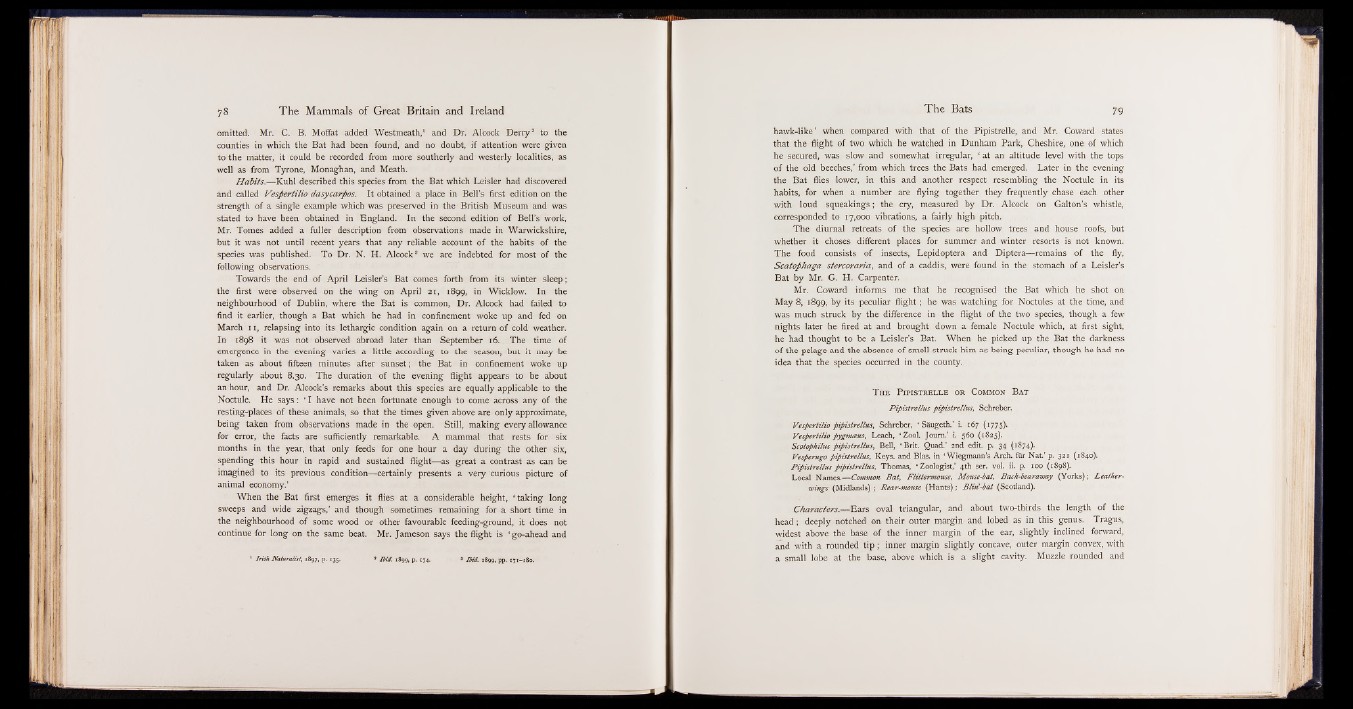
omitted. Mr. C. B. Moffat added Westmeath,1 and Dr. Alcock Derry2 to the
counties in which the Bat had been found, and no doubt, if attention were given
to the matter, it could be recorded from more southerly and westerly localities, as
well as from Tyrone, Monaghan, and Meath.
Habits.— Kuhl described this species from the Bat which Leisler had discovered
and called Vespertilio dasycarpos. It obtained a place in Bell’s first edition on the
strength of a single example which was preserved in the British Museum and was
stated to have been obtained in England. In the second edition of Bell’s work,
Mr. Tomes added a fuller description from observations made in Warwickshire,
but it was not until recent years that any reliable account of the habits of the
species was published. To Dr. N. H. Alcock8 we are indebted for most of the
following observations.
Towards the end of April Leisler’s Bat comes forth from its winter sleep;
the first were observed on the wing on April 21, 1899, in Wicklow. In the
neighbourhood of Dublin, where the Bat is common, Dr. Alcock had failed to
find it earlier, though a Bat which he had in confinement woke up and fed on
March 11, relapsing into its lethargic condition again on a return of cold weather.
In 1898 it was not observed abroad later than September 16. The time of
emergence in the evening varies a little according to the season, but it may be
taken as about fifteen minutes after sunset; the Bat in confinement woke up
regularly about 8.30. The duration of the evening flight appears to be about
an hour, and Dr. Alcock’s remarks about this species are equally applicable to the
Noctule. He says: ‘ I have not been fortunate enough to come across any of the
resting-places of these animals, so that the times given above are only approximate,
being taken from observations made in the open. Still, making every allowance
for error, the facts are sufficiently remarkable. A mammal that rests for six
months in the year, that only feeds for one hour a day during the other six,
spending this hour in rapid and sustained flight— as great a contrast as can be
imagined to its previous condition— certainly presents a very curious picture of
animal economy.’
When the Bat first emerges it flies at a considerable height, ‘ taking long
sweeps and wide zigzags,’ and though sometimes remaining for a short time in
the neighbourhood of some wood or other favourable feeding-ground, it does not
continue for long on the same beat. Mr. Jameson says the flight is ‘ go-ahead and
1 Irish Naturalist, 1897, p. 135. * Ibid. 1899, p. 174. * Ibid. 1899, pp. 171-180.
hawk-like’ when compared with that of the Pipistrelle, and Mr. Coward states
that the flight of two which he watched in Dunham Park, Cheshire, one of which
he secured, was slow and somewhat irregular, ‘ at an altitude level with the tops
of the old beeches,’ from which trees the Bats had emerged. Later in the evening
the Bat flies lower, in this and another respect resembling the Noctule in its
habits, for when a number are flying together they frequently chase each other
with loud squeakings; the cry, measured by Dr. Alcock on Galton’s whistle,
corresponded to 17,000 vibrations, a fairly high pitch.
The diurnal retreats of the species are hollow trees and house roofs, but
whether it choses different places for summer and winter resorts is not known.
The food consists of insects, Lepidoptera and Diptera— remains of the fly,
Scatophaga stercoraria, and of a caddis, were found in the stomach of a Leisler’s
Bat by Mr. G. H. Carpenter.
Mr. Coward informs me that he recognised the Bat which he shot on
May 8, 1899, by its peculiar flight; he was watching for Noctules at the time, and
was much struck by the difference in the flight of the two species, though a few
nights later he fired at and brought down a female Noctule which, at first sight,
he had thought to be a Leisler’s Bat. When he picked up the Bat the darkness
of the pelage and the absence of smell struck him as being peculiar, though he had no
idea that the species occurred in the county.
T h e P i p i s t r e l l e o r C o m m o n B a t
Pipistrellus pipistrellus, Schreber.
Vespertilio pipistrellus, Schreber, ‘ Saugeth.’ i. 167 (1775)*
Vespertilio pygmmis, Leach, ‘ Zool. Joum.’ i. 560 (1825).
Scotophilus pipistrellus, Bell, ‘ Brit. Quad.’ 2nd edit. p. 34 (1874).
Vesperugo pipistrellus, Keys, and Bias, in * Wiegmann’s Arch, ftir Nat.’ p. 321 (1840).
Pipistrellus pipistrellus, Thomas, ‘ Zoologist,’ 4th ser. vol. ii. p. 100 (1898).
Local Names.— Common B at, Flittermouse, Mouse-bat, Back-bearaway (Yorks); Leather-
wings (Midlands) ; Rear-mouse (Hants); Blin'-bat (Scotland).
Characters.— Ears oval triangular, and about two-thirds the length of the
head; deeply notched on their outer margin and lobed as in this genus. Tragus,
widest above the base of the inner margin of the ear, slightly inclined forward,
and with a rounded tip ; inner margin slightly concave, outer margin convex, with
a small lobe at the base, above which is a slight cavity. Muzzle rounded and